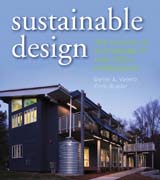
This introduction to concepts of sustainability and green engineering derivedfrom sound scientific principles is the first book to present the scientific principles at the heart of sustainable design. >From thermodynamics to fluid dynamics, computational chemistry to models, the principles in this book are illustrated with practical case studies from the author's own work. INDICE: Preface. Chapter 1. Design Cycles. Process: Linear and Cyclical Design. Synthesis-Integrated Design. Learning From Nature. Principles of Biomimicry. Materials Design. Tools For Collaborative Design. LEED. Open Source Software. ThinkCycle. BIM Tools. Integration and Collaboration. Notes and References. Chapter 2. First Principles. The Cascade of Science. Physics. Thermodynamics. Systems. Motion. Green Mechanics. Applications of Physics in Green Engineering. Mass and Work. Green Physics Example 1. Green Physics Example 2. Green Physics Problem 3. More About Forces. Environmental Dynamics. Fluids. Energy. Systematic Design and the Status Quo. Notes and References. Chapter 3. Transitions. A Brief History. How Clean Is Clean?. Donora, Pennsylvania. Love Canal, New York. The Bhopal Incident. Control. Ad Hoc and Post Hoc Life Cycle Perspectives. Intervention at the Source of Contamination. Intervention at the Point ofRelease. Intervention to Control the Exposure. Intervention at the Point of Response. Thermodynamics and Stoichiometry. Applying Thermal Processes for Treatment. Thermal Destruction Systems. Rotary Kiln. Multiple Hearth. Liquid Injection. Fluidized Bed. Multiple Chamber. Calculating Destruction Removal. Formation of Unintended Byproducts. Processes Other than Incineration. Pyrolysis. Emerging Thermal Technologies. Biology is the Green Engineer?s Friend. PollutionPrevention. Example Box: Waste Audit. Notes and Commentary. Chapter 4. Place and Time. Thermodynamics of Time and Space. Sidebar: Green Is Not Junk. Soil: The Foundation For Sustainable Sites. Green Architecture and the Sense Of Place. Pruitt Igoe: Lessons from the Land Ethic in 21st Century Design. Sustainability. The Tragedy of the Commons. Ethics of Place. Implementing Sustainable Designs. Whats Next?. Notes and References. Chapter 5. Optimizing for Sustainable Design. Revisiting the Harm Principle: Managing Risks. Justice: The Key to Sustainable Design. Evolution of Responsible Conduct. Concurrent Engineering. Benchmarking. Notes and References. Chapter 6. The Sustainability Imperative. Green Practice and the Case for Sustainable Design. The Engineer?s Social Responsibility: The Ethical and Social Dimensions of Sustainable Design. The Green Categorical Imperative. Environmental Justice. Environmental Impact Statementsand the Complaint Paradigm. The Role of the Design Professions. Professional Competence. Notes and References. Chapter 7. Carbon in the Atmosphere: Essential and Detrimental. Carbon and Rain. Back to Global Warming. Carbon Sequestration. Notes and References. Chapter 8. We Have Met the Future and it is Green. Science. The Professions. Governmental. Education. Energy. Economics. From Sustainable Design to Regenerative Design. Mass Production to Mass Customization.Lessons from the First-Years. Studio I - Survey the Literature. Studio II - Application of Principles and Concepts. Studio III - Innovation. Low-Tech Design Based on Outside the Box Thinking. Integrated, Life Cycle Thinking. Human Factors and Sustainability. Seeing the Future Through Green-Colored Glasses. Notes and Commentary. Index.
- ISBN: 978-0-470-13062-9
- Editorial: John Wiley & Sons
- Encuadernacion: Cartoné
- Páginas: 320
- Fecha Publicación: 30/04/2008
- Nº Volúmenes: 1
- Idioma: Inglés
